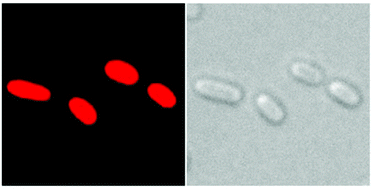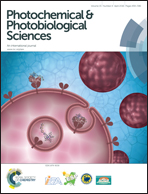Near infrared fluorescent biliproteins generated from bacteriophytochrome AphB of Nostoc sp. PCC 7120†
Abstract
The genome of the cyanobacterium Nostoc sp. PCC 7120 encodes a large number of putative bacteriophytochrome and cyanobacteriochrome photoreceptors that, due to their long-wavelength absorption and fluorescence emission, might serve as fluorescent tags in intracellular investigations. We show that the PAS-GAF domain of the bacteriophytochrome, AphB, binds biliverdin covalently and exhibits, besides its reversible photochemistry, a moderate fluorescence in the near infrared (NIR) spectral region. It was selected for further increasing the brightness while retaining the NIR fluorescence. In the first step, amino acids assumed to improve fluorescence were selectively mutated. The resulting variants were then subjected to several rounds of random mutagenesis and screened for enhanced fluorescence in the NIR. The brightness of optimized PAS-GAF variants increased more than threefold compared to that of wt AphB(1–321), with only insignificant spectral shifts (Amax around 695 nm, and Fmax around 720 nm). In general, the brightness increases with decreasing wavelengths, which allows for a selection of the fluorophore depending on the optical properties of the tissue. A spectral heterogeneity was observed when residue His260, located in close proximity to the chromophore, was mutated to Tyr, emphasizing the strong effects of the environment on the electronic properties of the bound biliverdin chromophore.



 Please wait while we load your content...
Please wait while we load your content...